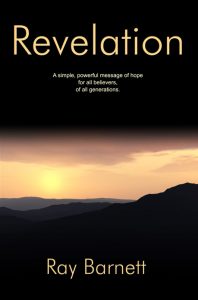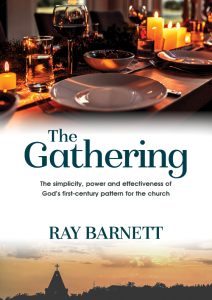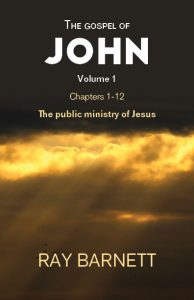YOU CAN UNDERSTAND REVELATION. It is not a complex serious of riddles, but a simple, powerful message of hope for all believers of all generations.
Revelation was written to first-century believers who were suffering for their faith. For them, it may have seemed like Jesus was not the King after all, and that God was not in control. Rome seemed to be winning. In images understood at the time, God spoke to their perplexity, fears and sorrows. He assured them that Jesus was King, that history was under control, and that they would share in the victory already won.
That simple message has been confused and buried under endless speculations about nuclear bombs, microchips, tattoos and all manner of mystical calculations. These wild speculations have universally neglected to take into account the circumstances of those first readers to whom it was addressed, and the literary genre in which it was written.
God was writing to bless, not to scare; to give hope and encouragement, not to create confusion; and to strengthen for daily living, not to make us preoccupied with every new scary story or technological development.
If you have been wearied, confused or troubled by complex modern Revelation theories, you will find this an easy-to-read, "conversational commentary" that focuses on the timeless message, and makes the fear and confusion give way to rejoicing.
ISBN: 978-0-9807440-5-7
Keys to understanding Revelation
The interpretation of any piece of literature is determined by the type of literature it is. A fairy story is not history; a poem is not prose; history is not allegory and so on. What you determine a document to be – its style and structure – will affect your reading of it.
READ MOREOne of the books my middle daughter studied in her literature degree at university was Alice in Wonderland. Before reading it, the students were told it was Lewis Carroll’s (Charles Dodgson’s) scathing attack on organised religion and society in general. So, on that basis, students plunged into the book finding all sorts of allusions to historical personalities, events, places, and organisations. And indeed, if you have already decided that that is what Alice in Wonderland is about, you can certainly make it say all of those things and more. You can probably work out who each character is, what mushrooms and roses represent, or what jabberwocky is. However, if – as is the case – you accept that its original intent was a story written for a little girl, a story just for the fun of it without the usual heavy moralism of the time, you will read Alice differently. In fact, you will read it as the author intended, and you will probably thoroughly enjoy it.
The same is true of any kind of literature, including the various types of literature in the Bible. Psalms are not prose, parables are not psalms, the Gospels are not allegory. As we come to interpret any portion of Scripture, we need to approach it according to the type of literature that it is. In a parable, for example, the meaning is not in the detail but in the overall point of the story. In the parable of the Good Samaritan we are not required to try and work out whether the coins represent baptism and the Lord’s Supper, whether the inn is the church, whether the donkey is the pastor, or the oil is a bucket of holy water at the entrance to a cathedral. To do so is ridiculous, and totally robs the story of its original purpose and impact. In the case of the Good Samaritan (Luke 10:25-37), a question was asked: “Who is my neighbour?” And an answer was given: “A certain man journeyed from Jerusalem to Jericho . . .” The meaning is not in the detail but in the story as a unit, because the whole story is the answer.
There is perhaps no portion of Scripture where the basic concepts of interpretation are abandoned more than the book of Revelation. The result has been that its message and impact have been lost in a sea of confusion and chaos. As we approach Revelation in this study, we will apply normal principles of interpretation. I have called them keys because they help us open its message. Please note that, while we are applying them to Revelation, they are the same sorts of procedures and interpretive disciplines that should apply to any portion of Scripture.
Key 1. The Style or Literary Genre
The book of Revelation is a specific style of Jewish literature. This cannot be overstressed. It is a recognisable, identifiable, unmistakable literary genre. It is apocalyptic literature. We find it in other portions of Scripture, however apocalyptic is a style not just confined to the Bible.
Apocalyptic is a style of writing that employs great images and symbols to convey truths that might not be readily discovered by normal investigation. Things from the spiritual realm, events behind the scenes, ideas beyond our finite understanding, are unveiled through great and overwhelming symbolism. Apocalyptic uses stars and angels, monsters and mountains, numbers great and small to convey the feeling or the impact of the truth even while the detail of the truth might be beyond human knowledge. As with parables, the message is not in the detail. Please underscore that in your mind – the message is not in the detail. It is not scientific literature with numbers that can be subjected to calculators and dimensions that translate into diagrams.
The message is in the overwhelming feelings and impressions conveyed through its images, and in the stark contrasts between good and evil.
Jewish writers were familiar with the concept of using huge, overwhelming images and hyperbole to speak to the heart about what God had done. Let’s look at an example of this style of writing, one set in the midst of an historical book. In Judges chapter 5, Deborah is rejoicing over the victory God won for the people of Israel. Look at some of the things she said . . .
“O LORD, when you went out from Seir, when you marched from the land of Edom, the earth shook, the heavens poured, the clouds poured down water . . . From the heavens the stars fought, from their courses they fought against Sisera.” (Verses 4, 20)
None of us imagines that God has two legs and marched out of the land of Edom, treading so heavily on the ground that the earth shook. Nor do we imagine that Alpha Centauri or the Orion constellation fought for Israel. No, the stars and the constellations all stayed where they had always been, providing pinpoints of light in the night sky. So is Deborah lying? Is she delusional? No, she is overwhelmed with joy and unable to even begin to suggest what events or forces might have been at work behind the victory, so she speaks in huge images that match the abundance of her heart. The images are so strong that everyone around her is drawn into the excitement of the song. God marched through the land! The land shook! The stars themselves fought on our behalf! Rejoice!
Three thousand years later, we still understand what she was saying far more so than if she had given us a scientific and detailed description of the battle.
So it is with apocalyptic literature. The first readers of Revelation would not have searched for hidden meanings and details but would have taken the impressions, and the weight and impact of the symbols, and been moved by the enormity of what God was saying to them. It is when we try to find an exact meaning for every detail, or an interpretation for every symbol, that we get off track. We effectively deny the type of literature, and foolishness results.
Stepping outside the genre for interpretation leads not just to foolishness but to serious mistakes that can end up mocking Christ and robbing the people of God of his message for them.
Common mistakes when we forget the nature of the literature
Mistake: It leads people to think that Revelation is only about the future
Forgetting the nature of the genre leads people to assume that the book is only about future events. The logic is simple: By assuming that all of the things described in Revelation are literal events, it becomes clear that we have not yet seen them. So if we haven’t yet seen them, they must still be in the future.
However, consider some of the Old Testament images we read without so much as a second thought. In Jeremiah’s day God told the people that he was going to send snakes through the land to devour them (Jeremiah 8:17). If we examine the historical record from Jeremiah’s day until today, we do not see that event happening. So are the snakes a future event? Working the way some readers do with Revelation, we would have to say yes; one day in the future, snakes will come and eat all the people in Israel. And wouldn’t we be foolish!
God’s word through Jeremiah was an image of death; an image that drew upon Israel’s history, taking their minds back to the time when snakes did come through the camp during the time of the exodus and death resulted (Numbers 11). Snakes did not come in Jeremiah’s day, but death and destruction did in the form of the Babylonian army. God went beyond the detail, sending a message to their hearts with an image of painful, irreversible death. It was an image with which they were familiar, a reality drawn from their past. The image is powerful, even though there is absolutely no physical comparison or resemblance between Babylonian soldiers and snakes.
In Revelation, we are told about scorpions with hair like women, teeth of steel, etc. So some end-time speculators try to create realities that look like, sound like, and act like such things and they come up with Black Hawk helicopters or Harrier Jump Jets with long vapour trails that look like hair. And foolishness pours down like rain. Stick with the genre! It is apocalyptic literature. The message is not in the details but in the overwhelming impressions.
Mistake: Revelation’s images must have an equivalent, identifiable reality behind them.
In Revelation, we are told of the mark of the beast. In my lifetime it has been authoritatively declared to be bar codes, credit cards, social security numbers and now it is a microchip – something that can be put on our forehead and wrist. After all, that is what the Bible says. So the race is on to be the first interpreter to identify what the “mark” literally is, or will be.
In the Old Testament, God told his people that his Word should be bound as a frontlet between their eyes, and put on their wrists and the doorposts of their houses. Thinking literally, they made small wooden boxes, put copies of the Law inside them, and wore them on their wrists and foreheads. We laugh and say how foolish to make such a command literal. It is easy for us to recognise that, by doing so, they missed the whole point of what God was saying! How could they so misunderstand the intent of God? God was not speaking about words in little wooden boxes strapped to wrists and foreheads, but about his Law in their minds and hearts and homes. Everything they did and thought should be touched by the Law of God.
Might not ancient Israel now laugh at us as we scare ourselves with each new literal possibility? Is God’s message to us that our eternal destiny is determined by a tattoo? Are we allowing ourselves to miss what God might be saying to us in the same way as Old Testament Israel missed the point?
Far more than foolishness, it becomes a major undermining of the Gospel. It sets the work of the cross against the ink of a tattoo. It makes the tattoo stronger than the cross, because the tattoo is capable of overturning the work of Jesus on our behalf. (We will think more about marks and mayhem when we get to that portion of Revelation.)
Revelation is apocalyptic literature employing symbols that go straight to the heart. They are symbols relevant to every generation and every culture, and they do not have to have a specific, literal, time-and-history equivalent behind them.
Mistake: Prophecy is always about the unknown future
Revelation claims to be a prophecy. For many, that word has come to be synonymous with telling the future, but that is not the way the Bible uses it. Prophecy may speak of future events or of past events, but it is a message for the present given to strengthen, encourage and edify the saints.
Our best definition of prophecy comes from 1 Corinthians 14:1-5. In that section, Paul is comparing the benefits of prophecy with the limitations of speaking in foreign languages to people who can’t understand them. In verse 3, he says, “. . . everyone who prophesies speaks to men for their strengthening, encouragement and comfort.” This is Paul’s description of prophecy. It is simple, clear and direct. If you want to see prophecy in action, look at Acts 15. The Galatian churches had been thrown into confusion by false teachers, and we read that,
Judas and Silas, who themselves were prophets, said much to encourage and strengthen the brothers. Acts 15:32
There you have prophecy in action.
The Old Testament prophets also took the Word of God and applied it to the current situation to strengthen, rebuke, correct, and encourage. They may have had a future component in their message, they also spoke of the history of the people, but their message was for “today”. They spoke God’s Word to the people in their day so that those people would be affected in their day, even by those things that were as yet to be fulfilled.
Mistake: Revelation’s secrets are locked in behind mysterious, coded symbols
Another serious mistake that occurs when we forget the nature of the literature of Revelation, is that it is seen to be a book of symbols that only the specially gifted or initiated can master. This then establishes an “end-times circuit” with these “specially gifted” people travelling from conference to conference, dazzling and frightening people with the latest speculations and fulfilments. But think about the nature of these apocalyptic symbols for a moment. Most of the symbols are universal. They are the images of dreams and nightmares: dragons, beasts, a hero on a white horse, a woman in distress, floods, falling stars, war, brides, thrones and harvest.
When we read of an angel taking his sickle and reaping the earth, we don’t try to analyse the sickle or work out how big it must be to reap the entire earth with one sweep. Are we cut off at the knees or does the blade of the sickle slip below the soles of our shoes? We are schooled enough in images to know that a sickle is an instrument of harvest; it is as simple as that. Even a child can understand it. Even in the West, where we don’t use sickles anymore, we still understand the symbol.
The light and colours of Revelation are also universal – red for bloodshed, light for goodness, darkness for evil. Heaven is high; its opposite is not just a pit but a bottomless pit – lower than the lowest. There does not need to be a literal pit that is “down”, just as heaven is not literally a piece of geography that is “up”. (After all, on a round earth, “up” for Australians is “down” for Russians and vice versa.)
Evil is like a prostitute; good is like a pure bride. Evil is destroyed in a banquet of blood and flesh, good is celebrated in a great wedding feast and so on. We understand these things. They are symbols that are universal and that don’t need analysis or particularised identification.
Probably the best interpreters are children, because they don’t try and make the symbols scientific or literal. Speak to them of dragons, earthquakes, floods and snakes and they take all the emotion of those images straight into their hearts and imaginations.
Revelation requires an ability to see the obvious, along with a child-like simplicity and receptivity. Adults compulsively complicate things to the point where they lie beyond normal comprehension. The purpose of the symbols is that they should be easily understood by all generations, in all cultures, in all of history. As the title of the book suggests, they are to reveal not to obscure.
However, a word of caution: to say that Revelation can be understood simply does not mean it is a simple book. As with all portions of Scripture, we need to reflect carefully on the message and its application.
We may need teachers to guide us, and we may need to stop and think for a while, but Revelation is not like the Greek mystery religions or Freemasonry, requiring secret knowledge held by a certain sect of the wise.
Revelation does not require major knowledge outside the Bible. It still has meaning for someone without CNN World News or the New York Times!
Mistake: Everything must be literal
It is by forgetting that it is apocalyptic literature, that people are drawn into our (particularly) Western desire to interpret every detail literally. Obviously, literal things do occur: there is a Christ, there is a Satan, there are enemies of Christ, there are martyrs, and so on. But those who try to make Revelation a literal book create enormous problems for themselves and everyone else because they are way out of line with the nature of the book. People will fight to the death over such things as a literal mark of the beast, a literal thousand-year reign on earth or a literal New Jerusalem descending from heaven. It must be interpreted literally, they say. But not a literal ten-horned beast, nor Jesus literally riding a horse with a sword in his mouth.
In fact, if we turn symbols into literal things, we have a remarkable Jesus! Jesus is a creature with four legs and a woolly jacket, he has seven eyes and seven horns, he sits on a white horse, and instead of a tongue, he has a sword in his mouth . . . Really? If we know anything about Jesus, we know that he is not a literal lamb! He was born of a virgin as a human being. But the term “lamb” is eternally powerful because it describes what his role was to be like – a sacrificial lamb. The word “lamb” is deeply and powerfully symbolic, but not literal.
We must be consistent then, in our treatment of the symbols. We do not feel we are being dismissive by not constructing a literal, woolly-skinned, four-legged Jesus with seven eyes. Nor are we being dismissive if we treat other symbols and images the same way. Look at what the image conveys about Jesus and rejoice. Then treat the other images in Revelation the same way. So much of the confusion caused by various treatments of this book arises when people step out of the literary genre and into literalism.
We should not be surprised if many different pictures or symbols speak of exactly the same thing. This is not a new concept for us. Ask Jesus what the Kingdom of Heaven is like, for example (Matthew 13). His answer will be that it is like a man sowing seeds in a field. It is like a mustard seed. It is like a net in the ocean. It is like yeast. It is like a pearl. It is like a treasure . . . Was Jesus confused? What is the relationship between a mustard bush and a pearl, or a net and a farmer? None, and yet each separate image or simile is speaking of exactly the same thing – the Kingdom of heaven. Why so many and such variety? Because each symbol adds another dimension to our understanding. In Revelation, Jesus can be a lamb, a lion, a horse rider, a man knocking at a door . . . Each image speaks of the same person but gives a different understanding of his character and function. Literalism creates enormous problems because literalism demands that each symbol describes something different.
No wonder a dear lady I spoke to in Russia said she no longer ever reads Revelation because it is just too confusing. What she had been taught was not only confusing, it was laughable.
Summary:
The first major key to understanding the book is to know what type of literature it is and then to doggedly, deliberately, unswervingly stick to the interpretive principles that relate to that type of literature. Revelation is not history; not anecdote; not allegory; it is apocalyptic. Underscore that in your mind, because as a modern, rationally educated, non-Jewish reader, you will always want to drop back into the ways of reading that you are used to and whenever you do, you will begin to create things that are just not in the book.
COLLAPSE





